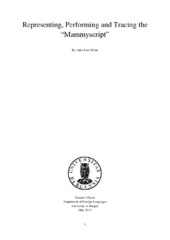Representing, Performing and Tracing the "Mammyscript"
Master thesis
Permanent lenke
https://hdl.handle.net/1956/10092Utgivelsesdato
2015-05-16Metadata
Vis full innførselSamlinger
Sammendrag
Since her origination in the antebellum South and up to around the 1960s the majority of the portrayals of the African American domestic worker in American literature represented her as the mammy. Improved rights for African Americans as result of the Civil Rights Movement lead to a decrease in the number of African American women going into domestic labour, and the Immigration Act of 1965 made changes in immigration politics. This was reflected in literature and popular culture representations of the domestic worker; the character was no longer African American, but predominantly Latina. In this thesis I focus on the representation of the fantasy of the mammy figure or stereotype. It has remained relatively static since its origination, and I shall argue that it can be localized through different echoes and traces in contemporary literature on the Latina domestic worker, or what I call Doméstic literature. In chapter 1 I outline how the mammy figure was shaped as a symbol of a fantasy, and as such, it itself became a fantasy. This we shall see by studying one particular embodiment of the mammy figure, used in advertisement for The Quaker Oats Company's products, namely Aunt Jemima." Through the notion of diacritical advertisement, which is focusing advertisement around ethnic and stereotypical traits which give specific associations to the product advertised, as well as framing and staging, the story of Aunt Jemima captures the essence of the mammy figure. She has however also set her footprints on later literary portraits of the mammy figure. In chapter 2 I will explore one of the more progressive and nuanced portraits of the mammy figure from the segregation era, namely the character of Delilah Johnston in Fannie Hurst's novel Imitation of Life (1933). I argue that a palimpsestic reading of this novel enables us to clearly see that the mammy figure, or what I call the mammyscript" rises to the surface and takes control over Delilah's own presentation. I chapter 3 I shall explore the contemporary representation of domestic worker, and I will echoes and traces of the stereotype in My Hollywood (2010) by Mona Simpson, Living Out (2005) by Lisa Loomer and América's Dream (1997) by Esmeralda Santiago. Through a study of different tropes we find traces and repetitions of the mammy figure. The Latina domésticas' employers contribute to this on their side by strong expectations, demands and staging toward a framing of the doméstica as a repetition of the mammy figure. As such, they place upon the doméstica a demand to live up to these expectations. We see that the mammy resumes her figure in these novel through the palimpsestuousness, an involutedness, an entanglement, of the layers in the material at hand, and the Latina doméstica and the mammy figure are co-constitutive. Sidan opphavet hennar i the Antebellum South og fram til rundt 1960-talet, har størsteparten av framstillingar av den kvinnelege Afro- Amerikanske domestic worker i Amerikansk litteratur representert henne som the mammy. Auka rettar for Afro-Amerikanarar gjennom Borgarrettigheitsrørsla gjorde at færre Afro- Amerikanarar gjekk inn i denne rolla, og the Immigration Act of 1965 gjorde endringar i innvandringspolitikk. Dette vart reflektert i litteratur og populærkultur, og figuren var ikkje lenger Afro-Amerikansk, men Latinamerikansk. I denne oppgåva tar eg for meg representasjonen av the mammy stereotype/figure som ein slags fantasi. Den har halde seg relativt uforandra sidan den vart forma, og eg argumenterer for at ein kan lokalisere den gjennom ulike ekko og spor i dagens litteratur om the Latina doméstica. I kapittel 1 greier eg ut om korleis mammyfiguren vart forma som eit symbol for ein fantasi, og korleis den dermed sjølv vart ein fantasi. Dette kan vi sjå gjennom å studere ei spesiell personifisering av mammyfiguren som enno vert brukt til å reklamere for the Quaker Oats Company sine produkt, nemleg Aunt Jemima." Vi ser at essensen til mammyfiguren er tilstade i historia til Aunt Jemima, mellom anna i det ein kallar diacritical advertisement, altså det å sentrere reklame rundt etniske og stereotypiske trekk som kan gje spesifikke assosiasjonar til produktet ein ynskjer å selje, samt innramming og iscenesetjing. Ho har i tillegg sett sine fotspor for seinare litterære portrett av mammyfiguren. I kapittel 2 ser eg på ein meir progressiv og nyansert representasjon av mammyportretta frå segregeringstida, nemleg karateren Delilah Johnston i Fannie Hurst sin roman Imitation of Life (1933). Her argumenterer eg for at ein gjennom ein palimpsestisk lesing av dette verket kan sjå at mammyfiguren, eller det eg kallar the mammyscript," kjem til overflata og tar kontroll over Delilah sin eigen presentasjon. I kapittel 3 er vi komne til dagens portrett av domestic workers, der eg lokaliserer ekkoa og spora av stereotypen, eller the mammyscript," i My Hollywood (2010) av Mona Simpson, Living Out (2005) av Lisa Loomer og América's Dream (1997) av Esmeralda Santiago. Gjennom ulike tropar ser vi spor og repetisjonar av mammyfiguren. Framstillinga av arbeidsgjevarane til the Latina domésticas bidreg på si side med sterke forventningar, og iscenesetjingar og innrammingar som krev ei forestilling frå the doméstica som ein mammyliknande figur. Vi ser at mammyfiguren figurerer og vert gjenoppliva i desse bøkene gjennom ei forvikling, eit samansurium, av dei ulike laga i materialet eg jobbar med, og at the Latina doméstica og mammyfiguren konstituerer kvarandre palimpsestuously, altså i ein relasjon, eit samspel som eigentleg ikkje skal vere der.
Beskrivelse
Revised version: small changes due to copyright issues
